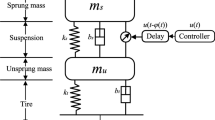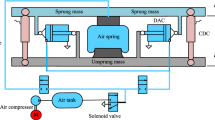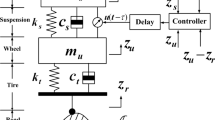Abstract
A new nonlinear adaptive control strategy for electrohydraulic active suspensions with the hysteretic leaf spring is proposed to improve suspension performances of heavy vehicle. The nonlinear hysteresis property of leaf spring, described and experimentally validated with the Bouc–Wen model, is transformed into linear system by Takagi–Sugeno (T–S) fuzzy approach. Based on the derived T–S fuzzy model, a robust \({H}\infty \) dynamic feedback control with adaptive gain is employed to generate the desired target forces for hydraulic actuators. A new projection-based adaptive control (PAC) law is further proposed for actuators to track the target forces under parametric uncertainties. The PAC law is derived based on the global asymptotic stability conditions of Lyapunov function for the obtained T–S fuzzy model with parametric uncertainties under inputs from both outputs of robust \({H}\infty \) controller and errors of force tracking. The benefits of vehicle systems with PAC active suspension are compared to both sliding mode control (SMC) active suspension and passive suspension. The obtained results indicate that the PAC method can be able to cope with uncertainties and has better robustness than SMC method. Furthermore, the obtained results also indicate that the proposed nonlinear adaptive control strategy effectively improves the suspension performances of heavy vehicle with the hysteretic leaf spring.

















Similar content being viewed by others
References
Cao, D., Rakheja, S., Su, C.: Heavy vehicle pitch dynamics and suspension tuning. Part I: unconnected suspension. Veh. Syst. Dyn. 46(10), 931–953 (2008)
Ding, F., Han, X., Luo, Z., Zhang, N.: Modelling and characteristic analysis of tri-axle trucks with hydraulically interconnected suspensions. Veh. Syst. Dyn. 50(12), 1877–1904 (2012)
Zhang, J., Zou, G., Zhang, N., Zheng, M., Zhang, B., Zhang, L.: Dynamic analysis of a vehicle with leaf spring based on the hysteresis model. Int. J. Veh. Perform. 4(3), 282–304 (2018)
Ahmadian, M.: Magneto-rheological suspensions for improving ground vehicle’s ride comfort, stability, and handling. Veh. Syst. Dyn. 55(10), 1618–1642 (2017)
Wang, R., Jing, H., Karimi, H.R., Chen, N.: Robust fault-tolerant \(\text{ H }\infty \) control of active suspension systems with finite-frequency constraint. Mech. Syst. Sig. Process. 62–63, 341–355 (2015)
Li, P., Lam, J., Cheung, K.C.: Motion-based active disturbance rejection control for a non-linear full-car suspension system. Proc. Inst. Mech. Eng. D J. Automob. Eng. 232(5), 616–631 (2017)
Du, H., Zhang, N.: Fuzzy control for nonlinear uncertain electrohydraulic active suspensions with input constraint. IEEE Trans. Fuzzy Syst. 17(2), 343–356 (2009)
Rebai, A., Guesmi, K., Hemici, B.: Adaptive fuzzy synergetic control for nonlinear hysteretic systems. Nonlinear Dyn. 86(3), 1445–1454 (2016)
Pi, D., Wang, X., Wang, H., Kong, Z.: Development of hierarchical control logic for two-channel hydraulic active roll control system. J. Dyn. Sys., Meas., Control 140(10), 101009 (2018)
Choi, H.D., Ahn, C.K., Lim, M.T., Song, M.K.: Dynamic output-feedback H \(\infty \) control for active half-vehicle suspension systems with time-varying input delay. Int. J. Control Autom. Syst. 14(1), 59–68 (2016)
Sun, X., Yuan, C., Cai, Y., Wang, S., Chen, L.: Model predictive control of an air suspension system with damping multi-mode switching damper based on hybrid model. Mech. Syst. Sig. Process. 94, 94–110 (2017)
Bououden, S., Chadli, M., Karimi, H.R.: A robust predictive control design for nonlinear active suspension systems. Asian J. Control 18(1), 122–132 (2016)
Huang, Y., Na, J., Wu, X., Liu, X., Guo, Y.: Adaptive control of nonlinear uncertain active suspension systems with prescribed performance. ISA Trans. 54(1), 145–155 (2015)
Dehghani, R., Khanlo, H.M., Fakhraei, J.: Active chaos control of a heavy articulated vehicle equipped with magnetorheological dampers. Nonlinear Dyn. 87(3), 1923–1942 (2017)
Li, H., Yu, J., Hilton, C., Liu, H.: Adaptive sliding-mode control for nonlinear active suspension vehicle systems using T–S fuzzy approach. IEEE Trans. Ind. Electron. 60(8), 3328–3338 (2013)
Jin, Y., Luo, X.: Stochastic optimal active control of a half-car nonlinear suspension under random road excitation. Nonlinear Dyn. 72(1–2), 185–195 (2013)
Sun, W., Pan, H., Gao, H.: Filter-based adaptive vibration control for active vehicle suspensions with electrohydraulic actuators. IEEE Trans. Veh. Technol. 65(6), 4619–4626 (2016)
Göhrle, C., Schindler, A., Wagner, A., Sawodny, O.: Road profile estimation and preview control for low-bandwidth active suspension systems. IEEE/ASME Trans. Mechatron. 20(5), 2299–2310 (2015)
Kumar, P.S., Sivakumar, K., Kanagarajan, R., Kuberan, S.: Adaptive neuro fuzzy inference system control of active suspension system with actuator dynamics. J. Vibroeng. 20(1), 541–549 (2018)
Wang, G., Chen, C., Yu, S.: Robust non-fragile finite-frequency \(\text{ H }\infty \) static output-feedback control for active suspension systems. Mech. Syst. Sig. Process. 91, 41–56 (2017)
Guan, Y., Han, Q., Yao, H., Ge, X.: Robust event-triggered \(\text{ H }\infty \) controller design for vehicle active suspension systems. Nonlinear Dyn. 94(1), 627–638 (2018)
Ma, M., Chen, H.: Disturbance attenuation control of active suspension with non-linear actuator dynamics. IET Control Theory Appl. 5(1), 112–122 (2011)
Yao, J., Jiao, Z., Ma, D.: A practical nonlinear adaptive control of hydraulic servomechanisms with periodic-like disturbances. IEEE/ASME Trans. Mechatron. 20(6), 633–641 (2015)
Yao, B., Bu, F., Reedy, J., Chiu, G.T.C.: Adaptive robust motion control of single-rod hydraulic actuators: theory and experiments. IEEE/ASME Trans. Mechatron. 5(1), 79–91 (2000)
Sun, W., Gao, H., Yao, B.: Adaptive robust vibration control of full-car active suspensions with electrohydraulic actuators. IEEE Trans. Control Syst. Technol. 21(6), 2417–2422 (2013)
Wang, D., Zhao, D., Gong, M., Yang, B.: Research on robust model predictive control for electro-hydraulic servo active suspension systems. IEEE Access 6, 3231–3240 (2018)
Chantranuwathana, S., Peng, H.: Adaptive robust force control for vehicle active suspensions. Int. J. Adapt. Control Signal Process. 18(2), 83–102 (2004)
Lin, J., Lian, R.J., Huang, C.N., Sie, W.T.: Enhanced fuzzy sliding mode controller for active suspension systems. Mechatronics 19(7), 1178–1190 (2009)
Shaer, B., Kenné, J.P., Kaddissi, C., Fallaha, C.: A chattering-free fuzzy hybrid sliding mode control of an electrohydraulic active suspension. Trans. Inst. Meas. Control 40(1), 222–238 (2018)
Kilicaslan, S.: Control of active suspension system considering nonlinear actuator dynamics. Nonlinear Dyn. 91(2), 1383–1394 (2018)
Ma, X., Wong, P.K., Zhao, J.: Practical multi-objective control for automotive semi-active suspension system with nonlinear hydraulic adjustable damper. Mech. Syst. Sig. Process. 117, 667–688 (2019)
Yao, J., Jiao, Z., Ma, D., Yan, L.: High-accuracy tracking control of hydraulic rotary actuators with modeling uncertainties. IEEE/ASME Trans. Mechatron. 19(2), 633–641 (2014)
Ikhouane, F., Rodellar, J.: On the hysteretic Bouc–Wen model. Nonlinear Dyn. 42(1), 63–78 (2005)
Li, L., Sandu, C.: Stochastic vehicle handling prediction using a polynomial chaos approach. Int. J. Veh. Des. 63(4), 327–363 (2013)
Guo, L., Zhang, L.: Robust \(\text{ H }\infty \) control of active vehicle suspension under non-stationary running. J. Sound Vib. 331(26), 5824–5837 (2012)
Luzi, A.R., Peaucelle, D., Biannic, J., Pittet, C., Mignot, J.: Structured adaptive attitude control of a satellite. Int. J. Adapt. Control Signal Process. 28(7–8), 664–685 (2014)
Peaucelle, D., Leduc, H.: Adaptive control design with s-variable LMI approach for robustness and \(\text{ L }_{2}\) performance. Int. J. Control (2018). https://doi.org/10.1080/00207179.2018.1554907
Cole, D.: Fundamental issues in suspension design for heavy road vehicles. Veh. Syst. Dyn. 35(4–5), 319–360 (2001)
Acknowledgements
This research was partly supported by the National Natural Science Foundation of China (Grant No. 51805155, Grant No. 51675152), Foundation for Innovative Research Groups of National Natural Science Foundation of China (Grant No. 51621004), Open Fund in the State Key Laboratory of Advanced Design and Manufacture for Vehicle Body (Grant No. 71575005).
Author information
Authors and Affiliations
Corresponding author
Ethics declarations
Conflict of interest
The authors declare that there is no conflict of interest in relation to this article.
Additional information
Publisher's Note
Springer Nature remains neutral with regard to jurisdictional claims in published maps and institutional affiliations.
Appendix
Appendix
Lemma 1
[20]. For any vectors \({\mathbf{x}},{\mathbf{y}}\in R^{n}\), and two matrices \({\mathbf{U}}\) and \({\mathbf{S}}\) with appropriate dimensions, if the appropriate dimension \({\varvec{\Delta }}\) satisfies \({\varvec{\Delta }}^{{\mathbf{T}}}{\varvec{\Delta }}\le {\mathbf{I}}\), then for any scalar \(\sigma _{0} >0\), we have
Proof of part A: Considering the tracking error \({\mathbf{e}}\) on the closed-loop system (15), the candidate Lyapunov function is defined as,
where \({\varvec{\upxi }}_{1} =[{\mathbf{x}}^{\mathrm{T}}\quad {\mathbf{y}}^{\mathrm{T}}\quad ({\mathbf{K}}_{h} -{\mathbf{K}}_{o} )^{\mathrm{T}}]^{\mathrm{T}}\), \({\tilde{{\mathbf{R}}}}=\mathrm{diag}[{\mathbf{R}}\quad {\mathbf{0}}]\).
Computing the time derivative of \(V_{1} (t)\) yields
in which \({\tilde{{\mathbf{w}}}}=\left[ {{\bar{{\mathbf{w}}}}^{\mathrm{T}}\quad {\bar{{\mathbf{w}}}}^{\mathrm{T}}} \right] ^{\mathrm{T}}\). Substituting the adaptive control laws (37) and (38) into \(2{\mathbf{e}}^{{\mathbf{T}}}{{\mathbf{B}}}_{2}^{\mathrm{T}} {\mathbf{Rx}}+{\mathbf{e}}^{{\mathbf{T}}}{\dot{\mathbf{e}}}\), the following transformation can be obtained
Then, substituting Eqs. (50) into (49), we have
Based on the inequality (19) and by using the Schur lemma, the following inequation holds
According to Lemma 1, we have \(2{\varvec{\upxi }}_{1}^{\mathrm{T}} {{\tilde{\mathbf{R}}}{\tilde{\mathbf{w}}}}\le \varepsilon ^{-1}{\varvec{\upxi }}_{1}^{\mathrm{T}} {\tilde{\mathbf{R}}{\tilde{\mathbf{R}}}\upxi }_{1} +\varepsilon {\tilde{{\mathbf{w}}}}^{\mathrm{T}}{\tilde{{\mathbf{w}}}}\) in which \(\varepsilon \) is a positive number. Thus, the following transformation can be expressed as
The positive number \(\varepsilon \) is chosen to satisfy \(\gamma ^{-2}-\varepsilon ^{-1}>0\) and define \(\varepsilon _{0} =\min \left\{ {\lambda _{\min } ({\tilde{{\mathbf{R}}}})(\gamma ^{-2}-\varepsilon ^{-1}),2\kappa _{1} } \right\} \) in which \(\lambda _{\min } ({\tilde{{\mathbf{R}}}})\) is the minimal nonzero eigenvalue of matrix \({\tilde{{\mathbf{R}}}}\). Then, we can obtain
where \(\varepsilon _{1} =2\varepsilon ^{-1}\max \left\| {{\bar{{\mathbf{w}}}}} \right\| _{2} +\kappa _{\mathrm{2}} +\varepsilon _{0} \max (Tr[({\mathbf{K}}_{h} -{\mathbf{K}}_{o} )^{\mathrm{T}}\mathrm{\varvec{\Theta }}({\mathbf{K}}_{h} -{\mathbf{K}}_{o} )])\), with \({\tilde{{\mathbf{w}}}}^{\mathrm{T}}{\tilde{{\mathbf{w}}}}\le 2\max \left\| {{\bar{{\mathbf{w}}}}} \right\| _{2} \) and \(Tr[({\mathbf{K}}_{h} -{\mathbf{K}}_{o} )^{\mathrm{T}}\mathrm{\varvec{\Theta }}({\mathbf{K}}_{h} -{\mathbf{K}}_{o} )]\le \max (Tr[({\mathbf{K}}_{h} -{\mathbf{K}}_{o} )^{\mathrm{T}}\mathrm{\varvec{\Theta }}({\mathbf{K}}_{h} -{\mathbf{K}}_{o} )])\). Thus, we can note that the Lyapunov function \(V_{2} (t)\) is bounded by
which demonstrates that all the signals \({\mathbf{x}}(t)\) and \({\mathbf{e}}(t)\) of the closed-loop system (2) are bounded.
Proof of part B: For the stability instruction in the presence of parameter uncertainties, we consider the augmented Lyapunov function as \(V(t)=V_{2} (t)+1/2{\tilde{{\varvec{\uptheta }} }}^{\mathrm{T}}{\varvec{\Gamma }}^{-1}{\tilde{{{\varvec{\uptheta }} }}}\), and the time derivative of V(t) is written as
Substituting the inequation (52) into Eq. (56), we can obtain
Combining Eqs. (37) and (38) with the inequation (57) results in
Due to the adaptation function \({\varvec{\upchi }}\) satisfying \({\varvec{\upchi }}={\mathbf{E}{\varvec{\Lambda }}}\), we have
Then, substituting Eq. (59) into inequation (58), the transformation of inequation (58) can be obtained
By the property P2 of Eq. (35), the following inequation holds
which demonstrates that all the signals \({\mathbf{x}}(t)\) and \({\mathbf{e}}(t)\) of the closed-loop system (2) can asymptotically converge to zero with a finite time.
Rights and permissions
About this article
Cite this article
Zhang, J., Ding, F., Zhang, B. et al. An effective projection-based nonlinear adaptive control strategy for heavy vehicle suspension with hysteretic leaf spring. Nonlinear Dyn 100, 451–473 (2020). https://doi.org/10.1007/s11071-020-05527-4
Received:
Accepted:
Published:
Issue Date:
DOI: https://doi.org/10.1007/s11071-020-05527-4




